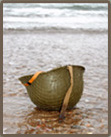Research Archives
The Museum collects research archives in virtually all areas of World War II. These are distinct from artifacts on exhibition. The research archives consist of letters, correspondences, diaries, journals and log books, photograph albums, newspapers, magazines, pamphlets, leaflets and all the other materials that reflect and give insight into life during the war are collected. The archives contain over 500,000 photographs and papers, 3,500 posters and 7,500 books.
Of particular research importance and interest are these collections:
PHOTOGRAPH ALBUMS
Approximately 2000 albums are currently included in the photographic archives. These are from all areas and aspects of the war from the pre-war home fronts of each country through invasions, occupations, bombings and liberations.
PROPAGANDA LEAFLETS
The collection of aerial leaflets dropped by planes or fired by artillery shells by all sides is virtually complete. Beginning with German leaflets to the French dropped during the "phony War", British leaflets to the Germans, leaflets dropped over London during the Blitz, Allied propaganda to the occupied countries, Germans to the Russians, the Russians to the Germans, extraordinarily rare leaflets delivered by V1 and V2 rockets and equally comprehensive archives in the Japanese war, the collections number well over 10,000 leaflets.
PHOTOGRAPHS
Many of the photographs are professionally done, but thousands were taken by civilians and soldiers. News photo archives are also included, presently over 75,000 in number.
BLACK PROPAGANDA.
The most fascinating area of propaganda, black, appears to orginate from one source when it is actually created by the opposition. German black was never well done and had no impact; British, on the other hand, was very cleverly done and very effective. This collection includes forged currency, postage stamps, newspapers, official army discharge documents, fake ration stamps, identity papers-just about everything was forged by the British. This section incorporates the collections of the pioneer collectors in this field and is exceeded only by the British Library.
FRENCH OCCUPATION AND RESISTANCE
Newspapers, handbills, posters, documents, leaflets and other printed pieces. This very comprehensive collection was formed by a Frenchman starting in 1945. To this collection has been added a very extensive museum collection of artifacts and posters, comprising thousands of pieces, concerning the German occupation, French prisoners of war, Resistance movements and activities and artifacts concerning Liberation. This archive numbers tens of thousands of pieces.
RUSSIAN INVASION
Included are the archives of the German plans to strip Russia of its natural resources [used as evidence at Nuremburg], a complete set of the invasion maps, booklets, bombing and artillery target maps, extensive Soviet propaganda posters, leaflets and pamphlets.
PRISONERS OF WAR
This is an area that I have been particularly interested in collecting because of my own fascination with how people survived. Many diaries and journals, camp newspapers, correspondence, photographs and drawings illustrate the yearnings for prisoners to be home. An extensive collection from Colditz Castle gives an intimate picture of life in the German's "escape proof" prison. The collection of every kind of escape device and forged papers rivals the Colditz Castle's museum collection. The collection is principally Allied prisoners of Germany, but also a surprising amount of material from Japanese camps.
DOUGLAS MACARTHUR
The extensive archives of MacArthur's Chief of Staff for Public Relations, are at the Museum and give an extraordinary insight into his life and actions from the Japanese air raid on Manila the day after Pearl Harbor, through the evacuation from Corregidor, the return to the Philippines and the Japanese surrender.
D-DAY
The D-Day collections are only rivaled, in artifacts, by the Bayeux Museum in Normandy. The only known complete original set of the D-Day invasion plans are in the archives along with thousands of other archival documents, photographs, plans and maps. The artifacts of four private D-Day museums in Normandy are also included in the museum.
OTHER AREAS
We include all areas of World War II in the research archives and we are always interested in new acquisitions that help to preserve and illuminate the reality of World War II.
YOU CAN HELP



